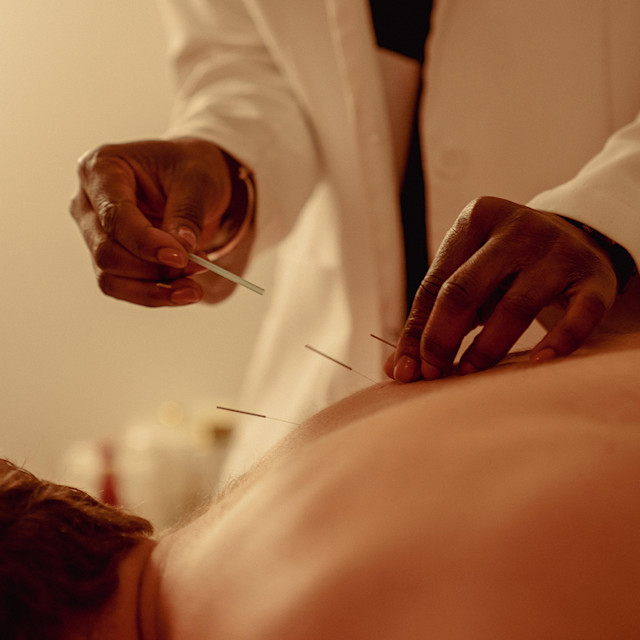This alternative treatment claims to relieve soreness, pain, and even stress.
Acupuncture is part of traditional Chinese medicine. It’s based on the idea that energy, or qi, flows through channels, called meridians, in the body. If this energy flow becomes unbalanced, it can lead to poor health, explains Gabriel Sher, the director of acupuncture at Ora.
Before you brush it off as “woo-woo” or esoteric, consider the fact that “acupuncture has been around too long and has too many good results for it not to be taken seriously,” says Sher. It’s actually the most widely used traditional medicine practice globally, according to a 2021 World Health Organization report.
Imagine a river and a dam. Your energy flow is the river, and blockages can stem from inflammation, injury, pain, and even emotional stagnation. “Acupuncture opens up that dam and gets everything flowing again to bring your body back into balance,” says Sher. If Western medicine is all about fixing a specific pathogen or problem, Eastern medicine — like acupuncture — is “more about always trying to find the balance, and regulating your system so everything runs smoothly,” he explains.

RELATED: Tap into Muscle Memory
It’s believed that acupuncture points stimulate the central nervous system, which releases chemicals into the muscles, spinal cord, and brain; as for how those mechanics work, scientists aren’t exactly sure. However, research on acupuncture continues to be conducted and studied. One 2022 analysis published in the BMJ determined that acupuncture is most effective in addressing neck, shoulder, and muscle pain, fibromyalgia pain, lactation issues after delivery, lower back pain, vascular dementia symptoms, allergy symptoms, and post-stroke aphasia. In his experience, Sher has also found acupuncture to be particularly helpful with stomach disorders (anything from constipation to irritable bowel syndrome), fertility issues, and emotional problems, like irritability, stress, and anxiety.
“The body has an amazing ability to heal on its own, but an acupuncturist acts like an air traffic controller — they’re telling the body what to focus on by directing energy,” says Sher. The body has 361 standardized acupuncture points, although traditional medicine practitioners believe there are more than 2,000 points connected to the body’s meridians. But let’s say you’re dealing with lower back pain. An acupuncturist may focus on points located directly on the lower back, or they might start at points on the feet, hands, hips, stomach, or the back of the knees in order to address blockages that might affect the lower back.
If the idea of inserting needles into your skin freaks you out, take a beat. “It’s not like a shot,” says Sher. “These needles are super, super thin — they’re hair-like. And they’re going through the skin super quick, so you usually don’t even feel it.”
The body has an amazing ability to heal on its own, but an acupuncturist acts like an air traffic controller — they’re telling the body what to focus on by directing energy.
Once the needles are in the skin — Sher usually applies the needles on 12 to 14 points, and the depth can be anywhere from less than half an inch to more than two inches — they stay there for 25 to 30 minutes. “As you sit with them, you can feel almost like an endorphin rush,” he explains. “You’re relaxing into your body.”
It actually could be an endorphin rush. When people underwent imaging scans while receiving acupuncture treatment, the areas of the brain associated with the release of endorphins lit up while the areas normally associated with pain showed reduced activity, according to research published in the journal Anesthesia & Analgesia.
This can be especially good for anyone dealing with pain — even if that pain is simple muscle soreness. “Chinese medicine is really good at just getting deeper under the skin and loosening the muscles,” says Sher. “I have athletes come in with anything from lower back or rotator cuff issues to really tight muscles in the neck and shoulder to just general soreness after a really hard workout.”
Sher encourages people to do acupuncture once per week or every other week. “It’s just really good, especially fitness-wise, to keep your system balanced, loosen up the muscles, and balance out your emotions,” he explains. Plus, how often do you get 30 minutes to just sit in your body and pay attention to things you don’t normally pay attention to? That’s restorative in its own right.
RELATED: The Science of BFR Training

Starting on Jan. 11, Ora — Sher’s acupuncture clinic — will offer acupuncture services at three of Equinox’s New York City Spas (Columbus Circle, West 92nd Street, and Brooklyn Heights), two days per week for six weeks in a row. This makes it super easy for any interested members to try it out for the first time or make a regular habit of it.
“It’s going to be a luxury experience,” says Sher, in case you needed more convincing. Not only will you have a relaxing, rejuvenating session, but it’s also going to be educational, he adds. “People like to pretend they know about Chinese medicine, but that’s Instagram Chinese medicine,” he says. “I want the people we see to understand why we used a certain needle, why we put it at a certain point and what our focus was. It’s a lot of teaching, and making people feel really comfortable and a little more aware of what’s going on inside their body.”
